Who's Who
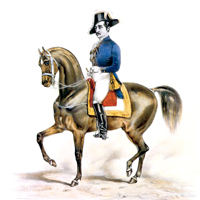
Baucher, Francois
Born : 1796
Died : 1873
François Baucher was born in Versailles near Paris on June 16, 1796.
At age 14, François Baucher was brought to Italy by an uncle who was managing the Milan stables of Camille Borghese, Prince of Sulmone, and husband of Pauline Bonaparte, a sister of Napoleon. Four years later, after the fall of Napoleon, Baucher returned to France. He worked for a short time in the stables of the Duke of Berry in Versailles, then decided to work for himself and by 1820 settled in Normandy where he managed first one, then two riding establishments, in Le Havre and Rouen.
Baucher was an outstanding rider, trainer, and riding teacher, but he deplored that the way horsemanship was taught at the time. He felt traditional teaching was unclear, vague, and futile, and he set out to create his own scientific system.
In her book, François Baucher, the man and his method, Hilda Nelson writes: “The goal of Baucher’s method is the total disposition of the horse’s strength and the total submission of the horse to the will of the horseman.”
Baucher discovered that the origin of the horse’s resistance lay in the wrong division of his mass on the ground, added to the poor mastery, by the rider, of his forces, which he called ‘instinctive’. The stiffness, the contraction of the forehand – neck, poll, and jaw – was according to Baucher what a horse uses in order to oppose his rider’s attempts at establishing a better division of his mass, and/or at curbing his ‘instinctive’ forces.
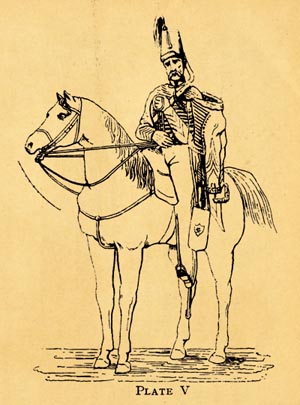
Baucher’s teachings are brilliantly explained in Racinet explains Baucher by Jean-Claude Racinet (Xenophon Press 1997):
“These contractions increase as the movement creates more momentum. Hence the proper education of a horse should start at a halt and from the ground by a set of flexions of the jaws, poll, and neck, added to some suppling exercises of the shoulders, haunches, and hindquarters. Then the same flexions should be made on horseback at a halt.”
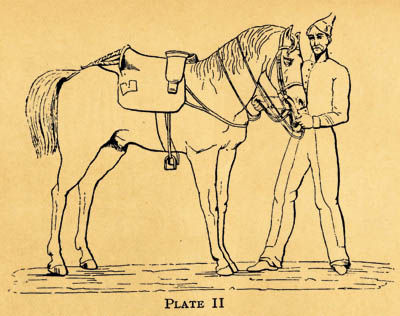
“Having in this way worked a horse ‘part by part’, Baucher would undertake the ‘reunion’ of the horse through an exercise he called effet d’ensemble, which is sometimes translated, poorly in my opinion, by ‘coordinated effect’. Fillis in Breaking and Riding calls it ‘general effect’, which is fairly good. ‘Comprehensive effect’ would still have been preferable, since the effet d’ensemble is an effect upon the whole of the horse, as opposed to the partial flexions which have preceded and prepared it.”
“The effet d’ensemble consists in applying simultaneously a progressive action of the legs and a corresponding resistance of the hand, in order to bring the horse to shorten his base of support, hence, collect himself. The effet d’ensemble is first practiced at a halt, then in motion, but at slow paces. The horse being made absolutely light in his front end through the direct flexions of the jaw (the head is vertical, the horse chomps his bit, and the reins are practically looped), and progressively accustomed to working on a shorter base of support through the effet d’ensemble, is then under the absolute dominance of his rider. He is ready for whatever the rider will please to order him.”
Baucher claimed that while his method looked slow, in fact it was faster than traditional methods and he claimed that in two and a half months, he could train any horse, with any conformation, to perform piaffe, passage and one times changes, a movement that Baucher had invented.
In 1833, Baucher published his first book, Dictionnaire raisonne d’equitation (A Rational Dictionary of Horsemanship).
Again, Racinet: “All his method – which was to undergo many transformations in the course of his life – was already in it. It was, after the words of General Decarpentry (a leading authority in matters of French horsemanship), “a revolutionary manifesto.” This however did little to make Baucher and his method known to the equestrian public at large, since he was exerting his profession in the province, far from Paris (by the standards of the time).”
“So in 1834 Baucher set out for Paris, where he hoped his talent would find more exposure. And this didn’t fail to happen. In 1837 he was hired with his horses (Partisan, Buridan, Neptune, and Capitaine) by Laurent Franconi, who was owning and managing the Cirque des Champs Elysees.”
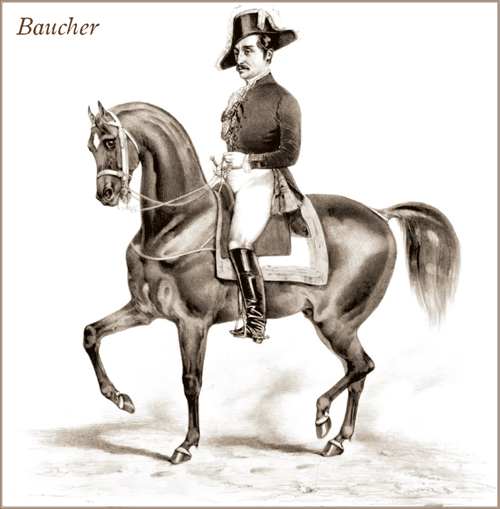
Baucher became an instant hit with the general public, but the source of controversy in the elite riding circles. His performance was startlingly new and included canter flying changes of lead at every stride, canter pirouettes on three legs, pirouettes at a piaffe whose cadence the rider would modulate at will, passage backwards and canter to the rear! France – or Paris at least – was divided into two warring camps, supporters and detractors.
In 1842 Baucher’s most important work was published: Methode d’equitation basee sur de nouveaux principes (Method of Horsemanship Based on New Principles). The book met with an immediate success with seven reprints in the next four years alone. The book only served to further outrage the traditionalists.
1842 was also the year when Baucher demonstrated his training skills with Gericault, a three-year-old Thoroughbred stallion who had bucked off all who tried to ride him. His owner, Lord Seymour, promised that he would give the horse to anyone who could ride him around the Bois de Boulogne. An anti-Baucherist, Vicomte de Tournon had tried and failed. Comte de Lancosme- Bresves, a recent convert to Baucher, succeeded in a way, surrounding himself with a group of mounted friends, riding so closely that Gericault hadn’t had much chance to fight.
Still, he had won the bet and Lord Seymour gave him the horse, which he in turn gave to Baucher. Baucher immediately declared that he would show Gericault at the circus within a month. 27 days later before a glittering crowd that included high society and the nobility, in the light of the gas chandeliers, amid the brouhaha of the crowd and the hubbub of the band, a calm and disciplined Gericault performed a program which included lateral work, canter pirouettes, single flying changes of lead, and a magnificent, slow, majestic rein back by which he went out of the ring.
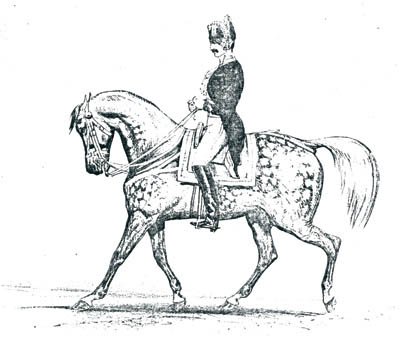
But there was another triumph in 1842, Baucher was asked to explain his methods to the Army. Major de Novital, head of the Cadre Noir and Major Rousselet, the leading rider, were summoned to Paris in order to meet Baucher and assess his work.
Racinet takes up the story: “Novital was enthused and immediately converted. Rousselet, although very appreciative, was more reserved. Baucher had given him one of his horses, Capitaine, to ride, and he felt disoriented. He was a very soft man, so he simply stated, as he dismounted, “II est trop fin pour moi” (this horse is too sharp for me).”
“Then about forty horses of the garrison of Paris were trained by their usual riders under the direction of Baucher. On April 3, after 26 lessons, at the rate of two short lessons a day, these horses were performing tight evolutions at a canter, individually or in groups, remaining perfectly on the bit.”
“Noted General Decarpentry in Baucher et son Ecole (p. 89): ‘Such a result was perhaps not unheard of in the best training performed in the old way, but it would have taken at least one year.'”
Other experiments took place, again with encouraging results but when the Duke of Orleans was replaced as the head of the Army by his brother Duke of Nemours, a student of d’Aure, the leader of the anti-Baucherists, the traditionalist gained the upper hand. The Duke of Nemours said: ‘Je ne veux pas d’une methode qui prend sur l’impulsion.’ (I do not want a method which restrains impulsion.)
Bacher’s most formidable opponent was the Count d’Aure, who, although an excellent High School rider himself was more interested in outdoor riding. His basic principle was to ride forward and retain the horse’s natural energy…
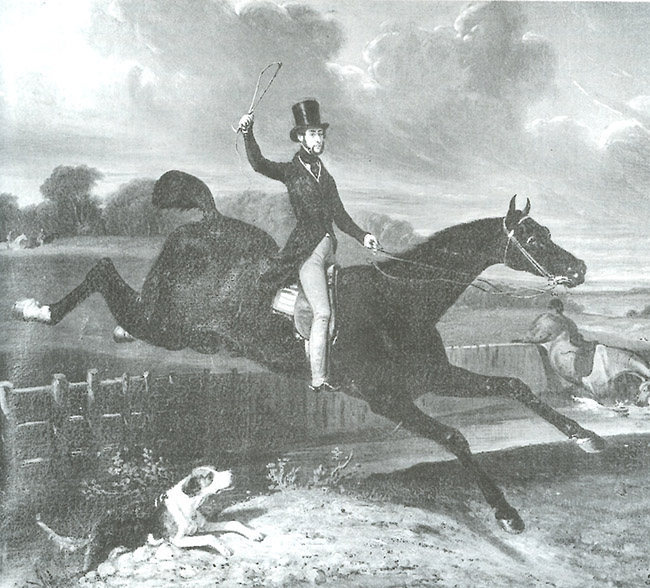
The Count d’Aure – natural riding
Baucher was sacked although he continued to influence many individual Army officers, so it was back to the circus. Baucher set out to tour Europe with the Dejean Circus and met with great success.
Baucher returned to Paris and while he was working a young horse in the circus ring, a huge chandelier fell on him. Luckily he survived but was so injured that he never rode in public again.
Without the strength of his legs, Baucher revised his method and developed his deuxième manière, which looked like a reversal of the first one. Let Racinet explain:
“In this second ‘manner’, the effet d’ensemble is no longer the cornerstone of the edifice. It is now performance only occasionally to calm a turbulent horse, and implies mandatorily the use of the spur. Lateral flexions of the neck and poll are still enforced, but are limited to an ‘eighth’ of flexion. The direct flexion of the poll (or ramner – a classical head set with the poll the highest point, and the forehead vertical) is no longer looked for directly, but is the result of the general attitude of the horse; it comes about progressively as the ‘rassembler’ (collection) perfects itself. In other words, the ‘ramener’ is no longer a prerequisite for collection, but its result, its expression.”
“This direct flexion of the poll is prepared by flexions of the jaw practiced with the head as high as possible, the forehead in a horizontal position.”
“Lightness is now sought by the hand alone, by means of ‘half-halts’ to oppose the ‘resistance of weight’ and ‘vibrations’ to oppose the ‘resistances of forces.”
Last but not least, the new axiom is set forth: ‘Hands without legs, legs without hand.”
“As he heard it, Major Gerhardt, an adept of the ‘first manner’ exclaimed, ‘Then Baucher is no longer Baucher!’ Quite the contrary, Baucher was becoming Baucher. This axiom ‘hand without legs, legs without hand’ appeared for the first time in 1864, with the 12th edition of the ‘method’. That’s quite a long time after the accident; but it is explained by the fact that the contract Baucher had with his publisher for all practical purposes prevented him from bringing any major changes in his text. Only by the 12th edition was he in a position to express himself more completely.”
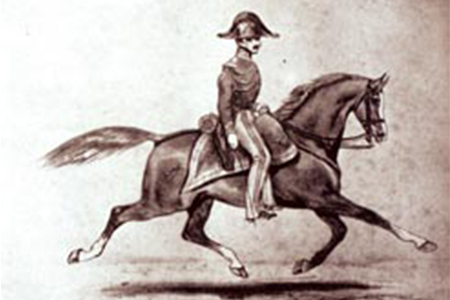
“As a matter of fact, Baucherism was a ‘permanent creation’, constantly perfected and constantly modified. The accident of 1855 acted as a mere catalyst and accelerated an evolution that was pointing toward the second ‘manner’ as we know it from the texts of the 12th and 13th editions of the ‘method’. A 14th edition, published posthumously, was edited jointly by Major Faverot de Kerbrech, one of Baucher’s best students, and Baucher’s son Henri.”
“The second “manner” was actively practiced by some officers in the French Army, and one can find its influence in the style of the French military dressage riders up to the 1950’s. Unfortunately, since Baucher did not show at the circus after 1855, this ‘reformed Baucherism’ did not get the exposure it deserved.”
“Baucher died on March 14, 1873. His last words were reported by General (then Colonel) L’Hotte, who was at his bedside: “Then taking my hand and giving it the position of the hand of curb” (main de bride – the left hand) he told me ‘Remember well: always this’ – and he immobilized my hand under the pressure of his, ‘never that’ and he drew my hand nearer my chest’.”
The Frenchman, Jean-Claude Racinet migrated to the USA in 1963, and became a spokesman for ‘L’equitation de Legereté, and spread the words of Baucher.
Another distinguished writer and trainer to arrive in the States was the Russian, Vladimir S. Littauer. He was more interested in jumping than dressage and in the forward thinking of the Caprilli School. Not surprisingly, he is less enthused about Baucher and kinder to his great rival d’Aure. So here in the interest of balance is a quote from Littauer’s neglected masterpiece, Horseman’s Progress – The Development of Modern Riding:
“It is quite obvious that Baucher, with his inclination toward the artificial, and the Count d’Aure, with his pursuit of simplicity and naturalness, could never agree. Possessing quite different temperaments, they even argued differently. Characteristic of Baucher was his self-assurances. For instance:
I say it out loud that full collection was never either understood or defined before me, because it is impossible to execute it perfectly without having applied successfully those principles which I have been the first to develop.
The Count d’Aure, on the other hand, presented his arguments in a mild manner, and occasionally with humour. This is how, for example, he treated some of Baucher’s ‘inventions’ – in this case the trot and gallop backward:
Today all we are concerned about are the aids to use when we wish to make a horse sit on the haunches and rein back; but no mention is made of those required to make him go forward. It is perhaps a strange and rare thing to see a horse trot and gallop backward, but, as use still requires a horse to move forward, and today perhaps more than ever, these are principles which it may be well to know.
It may be appropriate to mention here, that the fundamental theme of today’s major argument is the same – elaboration and artificiality as opposed to simplicity and naturalness.”
For a fascinating reconciliation of the principles of Baucher and de la Geurinière, go to
The integration of the Baucher system in the Classical School of de la Guérinière
by Miguel Tavora
